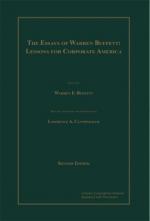
|
| Name: _________________________ | Period: ___________________ |
This test consists of 15 multiple choice questions and 5 short answer questions.
Multiple Choice Questions
1. Risk ___________ was defined as the pursuit of profits from anticipated events, according to the book.
(a) Memories.
(b) Movement.
(c) Arbitrage.
(d) Investing.
2. In some cases, the benefits of partial ownership earnings may far outweigh the ________ acquisition cost.
(a) Per-share.
(b) Market.
(c) Value.
(d) Fees and.
3. Value came from a fixed-income feature to set minimum value with __________ as a bonus.
(a) A strong management team.
(b) Conversion.
(c) A unique product.
(d) A good economy.
4. What was NOT one of the elements listed in the elements of arbitrage in the book?
(a) Likelihood that money is committed.
(b) Expected internal action.
(c) Change a competing event occurs.
(d) Length of time money is committed.
5. Some Berkshire insurance subsidiaries used _______ with its greater returns than to use Treasury Bils.
(a) Risky stocks.
(b) Investment games.
(c) Mediation.
(d) Arbitrage.
6. Who was the financial mentor that Buffett relied upon for his teachings and lessons about the way to do business?
(a) Ben Graham.
(b) No one.
(c) Himself.
(d) Charlie Munger.
7. Buffett's wealth was solely in _________ stock, investing and reinvesting dividends on its proportional increase per share market value over time.
(a) Berkshire.
(b) Wells Fargo.
(c) Coca-Cola.
(d) GEICO.
8. Buffett and Munger do not check _________'s manic depressive daily price quotes to validate their investment.
(a) Mr. Big.
(b) Mr. Market.
(c) Wall Street.
(d) New York Times.
9. What did the zero-coupon bonds not pay to the investor in the end?
(a) Profit.
(b) Locked in interest.
(c) Taxes.
(d) Current interest.
10. The $70B enterprise that Buffett and his partner buy includes GEICO and ________ corporation.
(a) Apple.
(b) Microsoft.
(c) General Mills.
(d) GE Re.
11. Buffett and Munger also followed the idea of minimal use of _______ and leverage, helping to create solid investments.
(a) Recovery.
(b) Debt.
(c) Consolidation.
(d) Divestment.
12. How much profit did the new holding of Berkshire make for Buffett and Munger?
(a) $150M.
(b) $250M.
(c) $500M.
(d) $100M.
13. Which of the partners had 99% of their net worth concentrated in Berkshire stock?
(a) Both.
(b) Buffett.
(c) Munger.
(d) Neither.
14. Munger and Buffett act like ________ when it comes to considering the economic prospects of the businesses they buy.
(a) Business analysts.
(b) Bankers.
(c) Kids.
(d) Stock traders.
15. The margin of ________ was the cornerstone of investment success, according to Graham.
(a) Risk.
(b) Reward.
(c) Safety.
(d) Error.
Short Answer Questions
1. Buffett and Munger invested based on company operating results and not on ____________.
2. The intrinsic business value goal was reached by ________, preferably 100% ownership of diverse business firms generating cash and above-average returns on capital.
3. Who did Buffett authorize to use the essays in the book to popularize the teachings and Buffett's own implementation of the teachings?
4. Buffett is proud that ____% of the shares outstanding at the end of each year were held by the same shareholders.
5. What was the name of the bank that had substantial equity interest in Berkshire?
|
This section contains 447 words (approx. 2 pages at 300 words per page) |

|




